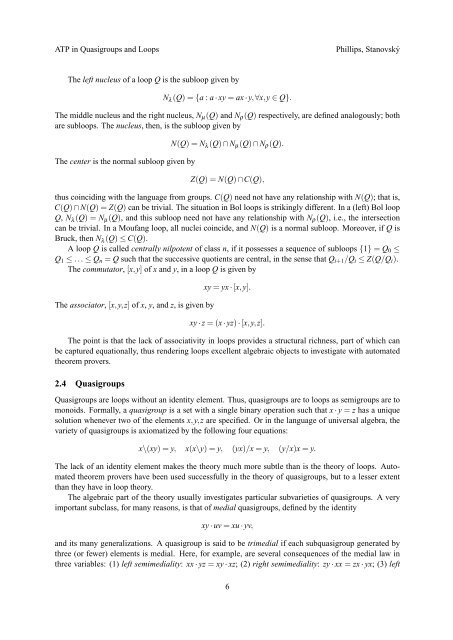Automated Theorem Proving in Quasigroup and Loop Theory
Automated Theorem Proving in Quasigroup and Loop Theory
Automated Theorem Proving in Quasigroup and Loop Theory
Create successful ePaper yourself
Turn your PDF publications into a flip-book with our unique Google optimized e-Paper software.
ATP <strong>in</strong> <strong>Quasigroup</strong>s <strong>and</strong> <strong>Loop</strong>s<br />
Phillips, Stanovský<br />
The left nucleus of a loop Q is the subloop given by<br />
N λ (Q) = {a : a · xy = ax · y,∀x,y ∈ Q}.<br />
The middle nucleus <strong>and</strong> the right nucleus, N µ (Q) <strong>and</strong> N ρ (Q) respectively, are def<strong>in</strong>ed analogously; both<br />
are subloops. The nucleus, then, is the subloop given by<br />
The center is the normal subloop given by<br />
N(Q) = N λ (Q) ∩ N µ (Q) ∩ N ρ (Q).<br />
Z(Q) = N(Q) ∩C(Q),<br />
thus co<strong>in</strong>cid<strong>in</strong>g with the language from groups. C(Q) need not have any relationship with N(Q); that is,<br />
C(Q) ∩ N(Q) = Z(Q) can be trivial. The situation <strong>in</strong> Bol loops is strik<strong>in</strong>gly different. In a (left) Bol loop<br />
Q, N λ (Q) = N µ (Q), <strong>and</strong> this subloop need not have any relationship with N ρ (Q), i.e., the <strong>in</strong>tersection<br />
can be trivial. In a Moufang loop, all nuclei co<strong>in</strong>cide, <strong>and</strong> N(Q) is a normal subloop. Moreover, if Q is<br />
Bruck, then N λ (Q) ≤ C(Q).<br />
A loop Q is called centrally nilpotent of class n, if it possesses a sequence of subloops {1} = Q 0 ≤<br />
Q 1 ≤ ... ≤ Q n = Q such that the successive quotients are central, <strong>in</strong> the sense that Q i+1 /Q i ≤ Z(Q/Q i ).<br />
The commutator, [x,y] of x <strong>and</strong> y, <strong>in</strong> a loop Q is given by<br />
The associator, [x,y,z] of x, y, <strong>and</strong> z, is given by<br />
xy = yx · [x,y].<br />
xy · z = (x · yz) · [x,y,z].<br />
The po<strong>in</strong>t is that the lack of associativity <strong>in</strong> loops provides a structural richness, part of which can<br />
be captured equationally, thus render<strong>in</strong>g loops excellent algebraic objects to <strong>in</strong>vestigate with automated<br />
theorem provers.<br />
2.4 <strong>Quasigroup</strong>s<br />
<strong>Quasigroup</strong>s are loops without an identity element. Thus, quasigroups are to loops as semigroups are to<br />
monoids. Formally, a quasigroup is a set with a s<strong>in</strong>gle b<strong>in</strong>ary operation such that x · y = z has a unique<br />
solution whenever two of the elements x,y,z are specified. Or <strong>in</strong> the language of universal algebra, the<br />
variety of quasigroups is axiomatized by the follow<strong>in</strong>g four equations:<br />
x\(xy) = y, x(x\y) = y, (yx)/x = y, (y/x)x = y.<br />
The lack of an identity element makes the theory much more subtle than is the theory of loops. <strong>Automated</strong><br />
theorem provers have been used successfully <strong>in</strong> the theory of quasigroups, but to a lesser extent<br />
than they have <strong>in</strong> loop theory.<br />
The algebraic part of the theory usually <strong>in</strong>vestigates particular subvarieties of quasigroups. A very<br />
important subclass, for many reasons, is that of medial quasigroups, def<strong>in</strong>ed by the identity<br />
xy · uv = xu · yv,<br />
<strong>and</strong> its many generalizations. A quasigroup is said to be trimedial if each subquasigroup generated by<br />
three (or fewer) elements is medial. Here, for example, are several consequences of the medial law <strong>in</strong><br />
three variables: (1) left semimediality: xx · yz = xy · xz; (2) right semimediality: zy · xx = zx · yx; (3) left<br />
6
















